

BEIJING, Oct. 10 (Xinhua) -- As visitors milled through the ancient courtyards of Nanchan Temple in Wutai County in north China's Shanxi Province, Ma Yongpeng stood among them, casually spinning a replica of the Monkey King's golden cudgel.
The young entrepreneur from Beijing, like many others recently drawn to the site, had come because of the globally acclaimed video game "Black Myth: Wukong."
Nanchan Temple -- home to one of Asia's oldest surviving wooden structures, dating back more than 1,000 years -- features prominently in the "Triple-A" game inspired by the classic Chinese novel "Journey to the West."
"I grew up playing video games, mostly imports from Japan, the United States, or Europe, crafted with incredible skill and attention to detail," he said. "In China, few games reach that level. But 'Black Myth: Wukong' is definitely one of the greats."
Captivated by the ancient structures and sculptures depicted in the game, Ma mapped out a nine-day trip across the province to gain first-hand experience, joining a wave of domestic travelers increasingly drawn by the country's cultural heritage.
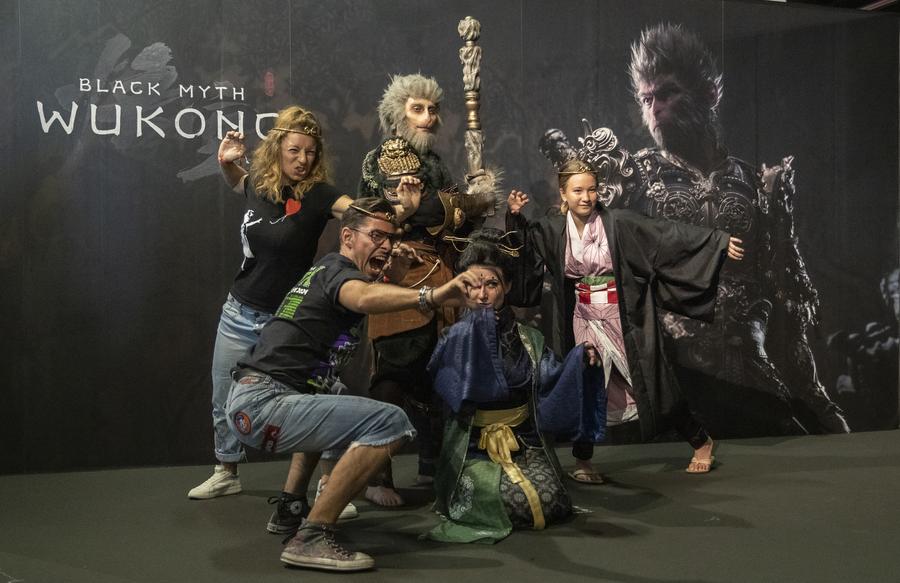
People pose for photos at the photo area of "Black Myth: Wukong" during Gamescom 2024 in Cologne, Germany, on Aug. 22, 2024. (Xinhua/Zhang Fan)
This trend reflects a broader vision gaining ground across the country, where tourism is seen as a way for people to better understand Chinese culture and grow more confident in it.
During the just-concluded eight-day National Day and Mid-Autumn Festival holiday, China recorded 888 million domestic tourist trips, up 123 million from the seven-day National Day holiday in 2024, according to official data released on Thursday.
In the same period, a total of 751,000 foreigners entered the country, including 535,000 under the visa-free policy, representing year-on-year increases of 19.8 percent and 46.8 percent, respectively.

An aerial drone photo taken on Oct. 4, 2025 shows tourists enjoying sunrise scenery at a viewing platform in Tiantai County of Taizhou City, east China's Zhejiang Province. (Photo by Lin Lijun/Xinhua)
TRADITIONS REBORN
One of this year's biggest cultural phenomena has been the animated blockbuster "Ne Zha 2," which challenged Hollywood's long-standing dominance of the global top-grossing film charts.
Like "Black Myth: Wukong," the film reimagines a Ming Dynasty (1368-1644) mythological tale, telling the story of Nezha, a boy with supernatural powers who also appears in "Journey to the West."
Its stunning success has turned the mythological figure into a modern cultural icon, with Ne Zha-themed merchandise selling out rapidly while the film was screened in theaters.
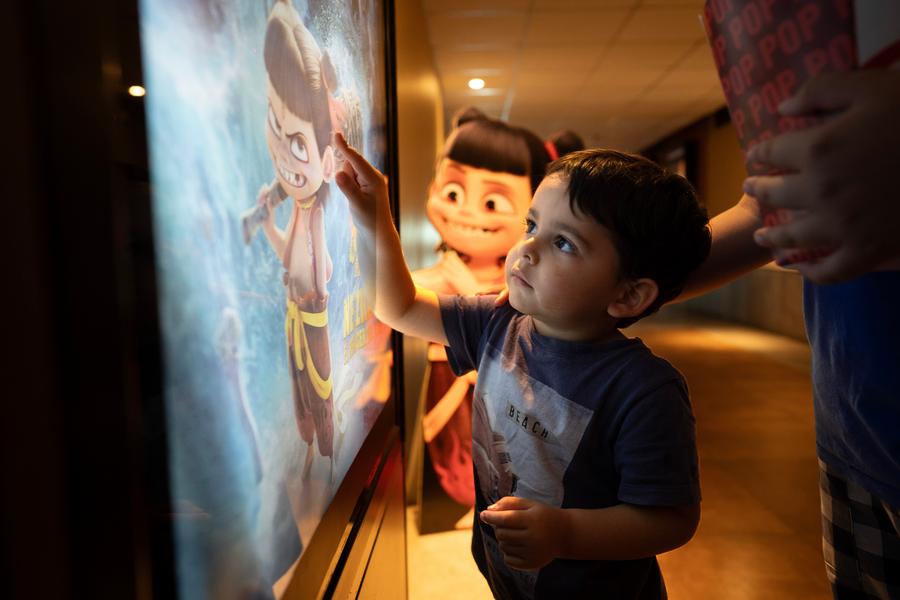
A boy points at a poster for the premiere of Chinese animated film "Ne Zha 2" in a cinema in Buenos Aires, Argentina, on Oct. 2, 2025. (Photo by Martin Zabala/Xinhua)
For young Chinese, this rising interest in Guochao, or "China-chic," has moved beyond visiting cultural heritage sites or buying cultural products. Some are now dedicating their lives to reinventing traditions.
Wu Houchen, 27, is one of them. After studying Chinese traditions in a metropolis, he returned to his hometown near Huangshan Mountain in east China's Anhui Province to run a fish-shaped lantern studio about three years ago.
Lanterns made by his young team come in both traditional bamboo-frame designs that preserve classic shapes, colors and dance forms, as well as new versions crafted from wire or plastic.
"Before, elderly villagers were skeptical of these creative ideas of the young people," Wu said, adding that attitudes of the locals toward the centuries-old craft have shifted in recent years as video clips of innovative designs went viral online and visitors flocked to the town to experience this intangible cultural heritage.
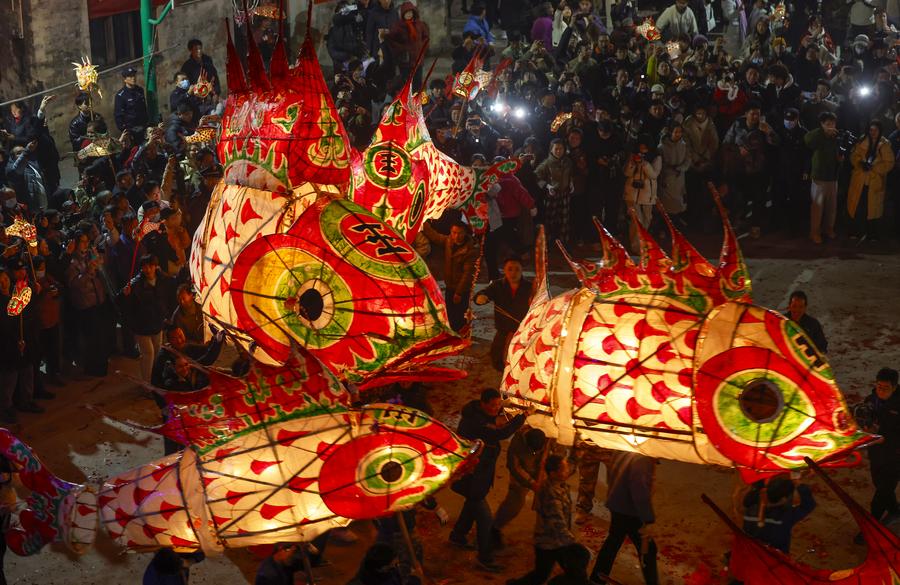
Villagers parade with fish-shaped lanterns in Wangmantian Village of Xitou Town in Shexian County, Huangshan City of east China's Anhui Province, Feb. 10, 2025. (Photo by Shi Yalei/Xinhua)
This revival of traditional culture is taking place across regions and among every ethnic group in the country.
In May this year, a rock version of the Manas epic -- a UNESCO-listed oral tradition of the Kirgiz ethnic group from northwest China's Xinjiang Uygur Autonomous Region -- was performed at a music festival in Nanjing, more than 4,500 kilometers from its place of origin.
The epic tells the story of the hero Manas and his descendants in their fight against evil, embodying perseverance, unity and courage.
"It was so powerful and exciting," said Lu Haojie, a tourist, describing the fusion of solemn traditional musical rhythms with electric guitar riffs.
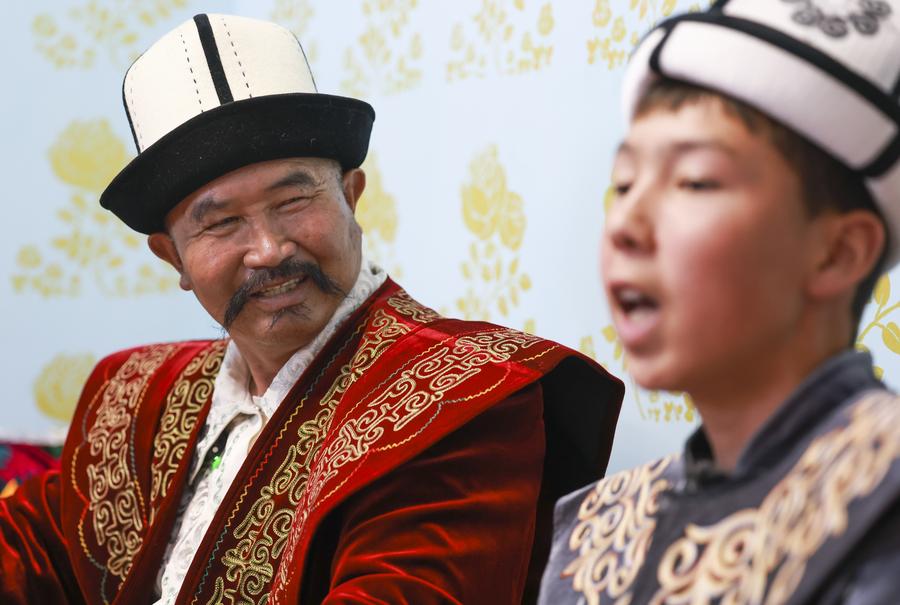
Jangnur Turganbay (L), a renowned inheritor of the "Manas" epic, teaches his apprentice to sing at his home in Artux City, Kizilsu Kirgiz Autonomous Prefecture, northwest China's Xinjiang Uygur Autonomous Region, April 21, 2025. (Xinhua/Wang Fei)
TECH MEETS CULTURE
In Shenzhen, visitors often queue outside the headquarters of BYD, the world's top-selling new energy vehicle manufacturer in 2024.
Inside, they discover more than just advanced cars and are immersed in stories of Chinese culture. BYD's models carry names like "Han" and "Tang," drawn from China's great dynasties, while one sub-brand's logo takes its inspiration from the oracle bone script character for "electricity."
"We don't change these features when selling overseas," a company official said. "They are Chinese-made cars. Buyers appreciate the charm of Eastern civilization."
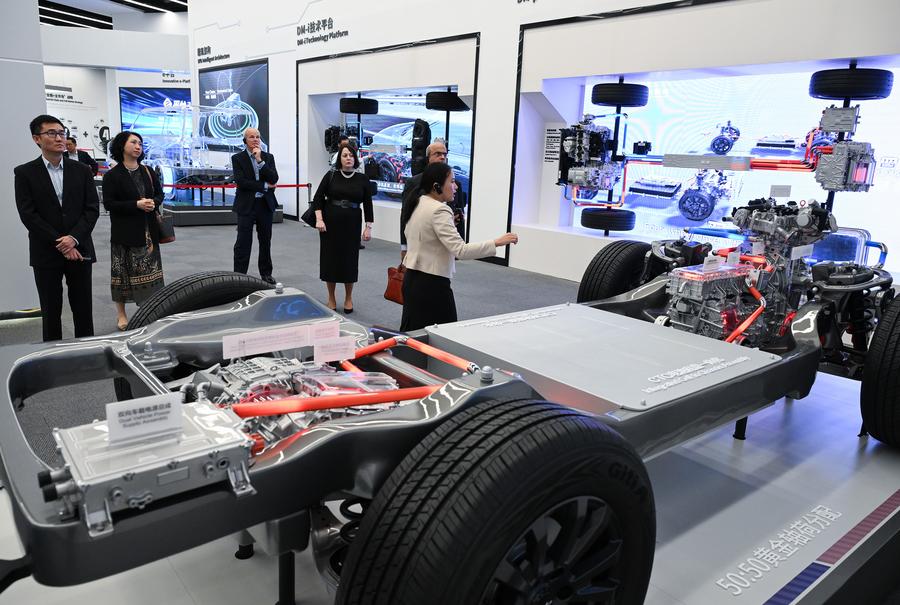
Foreign guests visit an exhibition hall of the headquarters of BYD in Shenzhen, south China's Guangdong Province, July 22, 2024. (Xinhua/Li He)
Beyond industry, technology is also giving new life to cultural treasures. In Luoyang City, central China's Henan Province, the inscriptions of the Longmen Grottoes are brought to life through AI algorithms and augmented reality (AR) infrared triggering technology. When visitors touch a character, it is recreated in oracle bone script, inscriptions, official script, cursive, running script and other traditional fonts.
Even the success of "Ne Zha 2" owes much to the advances in technology, with its animation combining AI and deep-learning emotion synthesis to create breathtaking visuals.
The blockbuster came two years after "The Wandering Earth 2," a sci-fi epic adapted from Hugo Award-winner Liu Cixin's novel, which showcased China's advances in 3D-printed props and CGI.
From silent films to AI-powered blockbusters, Chinese cinema is now merging cutting-edge tech with 5,000 years of culture-creating stories that resonate worldwide.
"As China's national strength grows, its culture will inevitably exert greater global influence; not by simply reproducing the past, but by creating new cultural forms oriented toward the future," said Liu, author of "The Three-Body Problem."
MUTUAL LEARNING
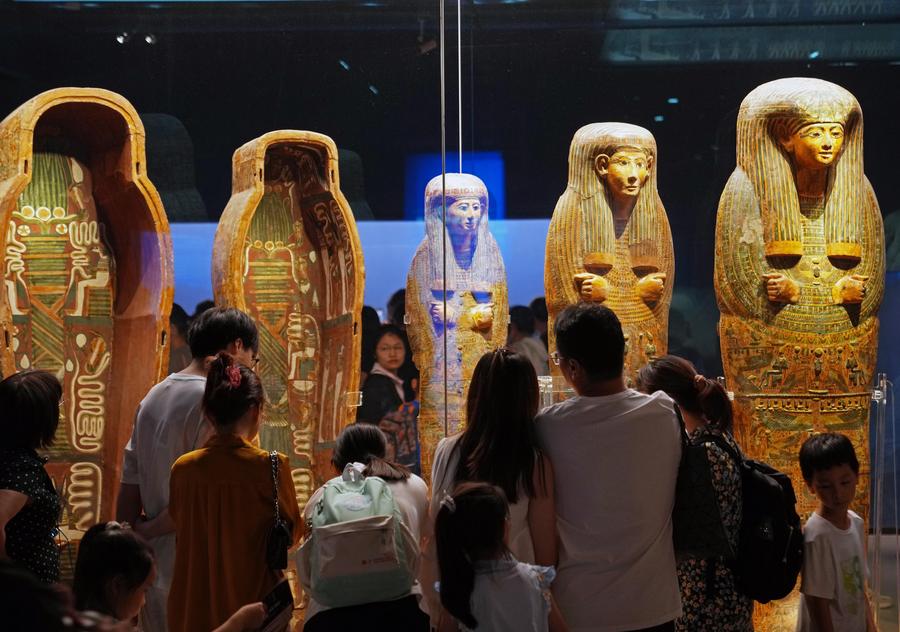
People visit the exhibition "On Top of the Pyramid: The Civilization of Ancient Egypt" at the Shanghai Museum at night in Shanghai, east China, Aug. 11, 2025. (Xinhua/Liu Ying)
While deepening their interest in China's own traditions, Chinese people are also eager to explore the cultural heritage of other countries. This August, a grand exhibition on ancient Egyptian civilization -- the largest of its kind held outside Egypt in two decades -- concluded a 13-month run at the Shanghai Museum, drawing a total of 2.77 million visitors.
"The exhibition truly broadened our horizons and built a bridge for civilizational exchange," said Wang Fei, a white-collar worker from Shanghai, noting that people no longer come just to buy merchandise but to learn, to appreciate beauty, and to understand.
Inspired by the experience, Wang later traveled to Egypt with her family for a deeper, firsthand encounter with its ancient sites.
The event, which showcased 788 Egyptian artifacts alongside ancient Chinese relics, exemplified China's increasing focus on cultural exchanges and mutual learning among civilizations in recent years.
In recent years, various activities were organized both in China and abroad and cross-cultural platforms like the Liangzhu Forum and World Conference of Classics have been initiated in recent years to highlight the Chinese civilization and enhance exchanges and mutual learning among civilizations.
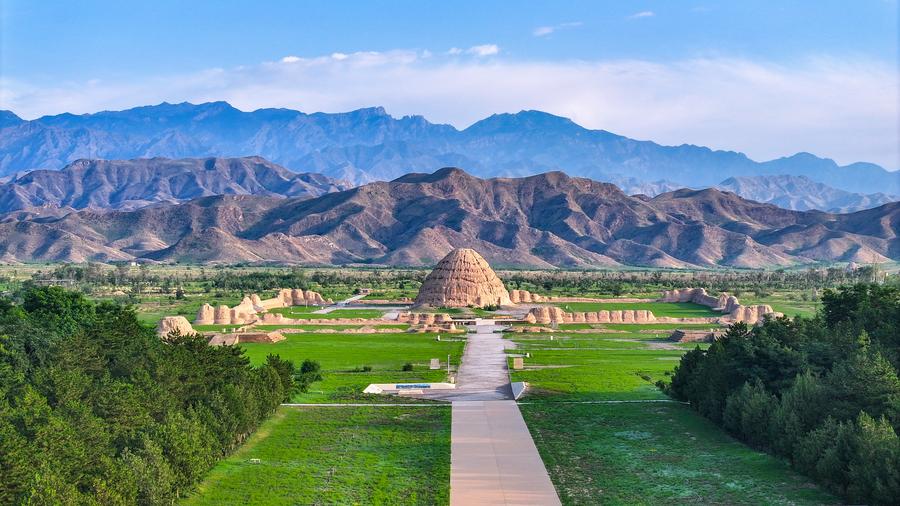
A drone photo taken on July 10, 2025 shows a view of the No.3 tomb of the Xixia Imperial Tombs in Yinchuan, northwest China's Ningxia Hui Autonomous Region. (Xinhua/Feng Kaihua)
Spanning more than 5,000 years, Chinese civilization continues to engage with other cultures and influences the Chinese people in many ways.
China's DeepSeek model, with its low barriers and open architecture, embodies the inclusive spirit of Chinese civilization, said Chang Lih Kang, Malaysia's minister of science, technology and innovation.
(Video reporters: Liu Yutian, Lou Tianqi, Zhu Jingle, Hong Liang, Xie Yuan, Wang Jialin, Wu Hongbo, Xu Wei, Sun Zhenghao, Yu Xiaosu, Chen Jie, Yang Kai, Duo Lei, Fan Peishen, Zhang Rui, Wu Lu, Zhang Boning, Guo Shuang, Li Xuejun, Relja Dusek, Ding Ting, Sun Liping, Li Haiwei, Wen Xinnian, Zhao Danliang, and Xia Yuanyi; video editors: Wang Houyuan, Hui Peipei, Roger Lott, and Zheng Qingbin)
点击右上角![]() 微信好友
微信好友
 朋友圈
朋友圈

请使用浏览器分享功能进行分享
